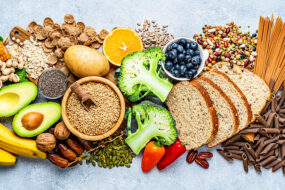How to get the right balance of carbs for you
Carbs are back, baby – but it’s all about figuring out how much you need and which types are best for you.
Dietitian Susie Burrell reveals the easy steps to take to get your balance right.
Be fussy with the type of carb
Carbs are found in plant-based foods and include fruits, starchy vegetables and legumes, grains and sugars like honey and sugar.
While the body can use both complex and simple sugars, wholegrain carbohydrates and those found in whole foods such as legumes, fruit and starchy veggies like sweet potato are more nutrient-rich and digested more slowly than processed carbs found in snack foods, white varieties of bread, rice, pasta and sugars.
For this reason getting your carbs from these whole foods is a good starting point.
Aim for a carb at each meal
Every person is different and as such will have different carbohydrate requirements depending on age, activity levels and energy demands.
But as a starting point, aiming for one carb-rich food at each meal and snack will help to keep blood glucose levels controlled and aid hunger management.
A serve is roughly ½ cup of veggies or legumes, one piece of fruit or one slice of bread.
Pay attention to your hunger
Constantly feeling hungry can be a sign that your overall carb intake is too low for your energy demands.
If this sounds familiar, increase the amount of carbs you are having at meals.
For example, if you are generally hungry an hour after lunch, add an extra 1/2 cup of carbs, a piece of wholegrain bread or fruit to see if you simply need a little more fuel.
The average female will need at least 100-150g of carbs a day, and eating considerably less than this can drive cravings and constant hunger.
- Insatiable: 8 reasons you are hungry all the time
Watch the added sugars
There is a big difference nutritionally between naturally occurring sugars in food and added sugars.
Added sugars found in snack foods, baked goods and sweet treats are a concentrated source of energy that offer little nutritionally and are easily over consumed.
For this reason, limiting your intake of added sugars to 25g or less each day will go a long way in keeping your overall carb intake on track.
A quick check of food labels can help you to keep your added sugar intake controlled.
Look for packaged foods with less than 5g of sugars per serve.
Added sugars may also be described as rice malt syrup, glucose, rice starch, honey and syrup.
- Quick and dirty: The ultra-processed foods to avoid (and what to eat instead)
Cut back if you need to lose weight
As carbs are the primary fuel for the muscles and the brain, we need a certain amount to keep the metabolism pumping.
But it is also possible to overdo them, especially if your goal is weight loss.
So if you are keen to lean up a little, lowering your intake of carbs is a way to safely drop kilos while still giving your body the energy it needs throughout the day.
Think protein teamed with salad and non-starchy veggies rather than heavier rice and pasta based-meals.
More healthy eating advice:
- Which style of fasting is right for you?
- Why 10 is the magic number for fruit and veg intake
- Dietitians reveal the ‘healthy foods’ that really aren’t good for you
Written by Susie Burrell.





